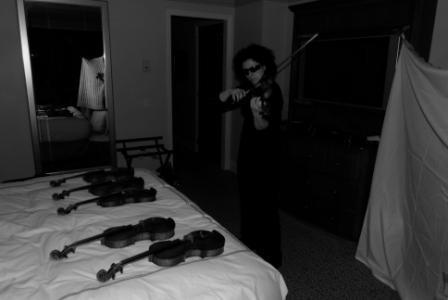What really happened in an Indianapolis hotel room with six top violins? Ariane Todes reveals all

For the last few days worldwide media have been in a twist about
research that seems to prove that violinists can’t tell the
difference between a modern violin and a Stradivari. As ever, it’s
not that simple. I should know – I was there. On my visit to the
Indianapolis Violin Competition last year, I spent an hour in a
hotel room with goggles on, playing six fiddles – three moderns,
two Stradivaris and a ‘del Gesù’.
I’m not a professional violinist, but I studied at the Royal
Academy of Music and nearly became one. And as editor of The Strad
for the last five years, I’ve been privileged to hear the greatest
players on the best instruments, and to play some of the finest
instruments in the world. Does any of this disqualify me from
counting in such research? It's an appropriate question. After all,
who is best-suited to judge sound? An instrument geek who has a
library of classic violin sounds in their memory? Someone with
fresh ears? A top soloist who knows how to project to the back of a
hall? A chamber musician who looks to blend? Any of these factors
might have a profound bearing on the outcome of such a study.
I remember coming out of the room exhausted by the mental effort of
hearing, verbalising and choosing continuously for an hour. There’s
a bell curve in attention levels with such an experiment. At the
start it takes a few minutes for the ear to tune into each of the
characteristics you’re being asked about and to sort them out.
After a few goes, you get your head round it, but then fatigue and
self-doubt set in. Are you judging consistently? Are you focusing
evenly? Are you remembering accurately? Are you picking up subtle
clues from the worn feeling of the fingerboard, the smoothness of
the neck? Is your agenda to prove your own knowledge, or are you
truly open to the experience?
The good news is that I was largely consistent – the instrument I
chose to take home at the end was the 'del Gesù'. And for the pair
comparisons in the first round, I always chose the 'del Gesù' over
the modern instrument, although I often chose a modern instrument
over the Stradivaris. I assumed the 'del Gesù' was a Stradivari
because I thought I found it difficult to play initially. Strads do
require special attention technically, which might explain the lack
of positive results for them, and provide an argument that such
tests should use players who are used to getting the most from a
Strad. Or the opposite.
My comments about the ‘del Gesù’ were, ‘There is a solidity to the
sound, a core which is sweet. It plays nicely quickly,’ although
elsewhere I described it as hard to play. In retrospect, I also
question using the word sweet – did I genuinely think that or was
my notion that it was a Strad influencing me? As with other
participants, my answers slightly favoured the modern instrument
known as M2 – I thought it was the most playable and that it could
be a ‘del Gesù’.
What does the study prove? It's a stretch to get to the
myth-busting generalisation that violinists can't tell a Strad from
a modern instrument. There are too many philosophical issues and
variables to be definitive about that. However the data clusters
around a popular modern instrument and an unpopular Stradivari
force one to consider the preconceptions that are so hardwired.
Although of course, here at The Strad, it comes as no surprise to
us that modern instruments can sound fantastic.
Taking part in the test showed me that it’s exceedingly hard to be
objective, consistent and fair, but that maybe there's nothing
wrong with a bit of subjectivity, as long as it's honest. And that
I should have asked for a ‘del Gesù’ for Christmas.
For more details about the experiment and to find out how to set up
your own blind test, read Joseph Curtin’s article in the February
issue of The Strad, out 20 January.








































No comments yet